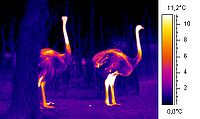
Photo from wikipedia
Reconstructing 3D human shape and pose from monocular images is challenging despite the promising results achieved by the most recent learning-based methods. The commonly occurred misalignment comes from the facts… Click to show full abstract
Reconstructing 3D human shape and pose from monocular images is challenging despite the promising results achieved by the most recent learning-based methods. The commonly occurred misalignment comes from the facts that the mapping from images to the model space is highly non-linear and the rotation-based pose representation of the body model is prone to result in the drift of joint positions. In this work, we investigate learning 3D human shape and pose from dense correspondences of body parts and propose a Decompose-and-aggregate Network (DaNet) to address these issues. DaNet adopts the dense correspondence maps, which densely build a bridge between 2D pixels and 3D vertexes, as intermediate representations to facilitate the learning of 2D-to-3D mapping. The prediction modules of DaNet are decomposed into one global stream and multiple local streams to enable global and fine-grained perceptions for the shape and pose predictions, respectively. Messages from local streams are further aggregated to enhance the robust prediction of the rotation-based poses, where a position-aided rotation feature refinement strategy is proposed to exploit spatial relationships between body joints. Moreover, a Part-based Dropout (PartDrop) strategy is introduced to drop out dense information from intermediate representations during training, encouraging the network to focus on more complementary body parts as well as neighboring position features. The efficacy of the proposed method is validated on both indoor and real-world datasets including Human3.6M, UP3D, COCO, and 3DPW, showing that our method could significantly improve the reconstruction performance in comparison with previous state-of-the-art methods. Our code is publicly available at https://hongwenzhang.github.io/dense2mesh.
Journal Title: IEEE Transactions on Pattern Analysis and Machine Intelligence
Year Published: 2022
Link to full text (if available)
Share on Social Media: Sign Up to like & get
recommendations!